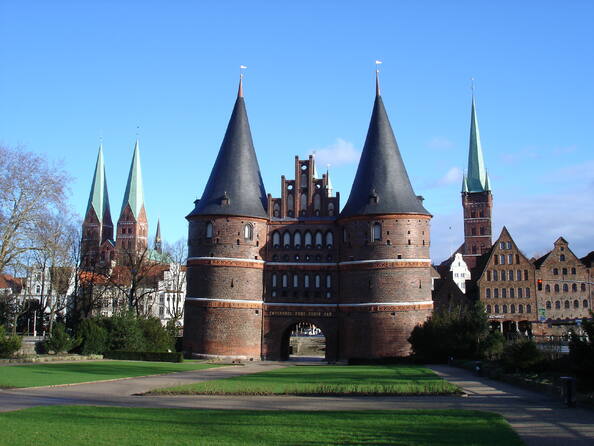Ciudad hanseática de Lübeck
Hanseatic City of Lübeck
Lübeck – the former capital and Queen City of the Hanseatic League – was founded in the 12th century and prospered until the 16th century as the major trading centre for northern Europe. It has remained a centre for maritime commerce to this day, particularly with the Nordic countries. Despite the damage it suffered during the Second World War, the basic structure of the old city, consisting mainly of 15th- and 16th-century patrician residences, public monuments (the famous Holstentor brick gate), churches and salt storehouses, remains unaltered.
Description is available under license CC-BY-SA IGO 3.0
Ville hanséatique de Lübeck
Ancienne capitale de la Ligue hanséatique et reine de la Hanse, elle a été fondée au XIIe siècle et fut jusqu'au XVIe siècle la métropole du négoce pour toute l'Europe du Nord. Elle reste encore aujourd'hui un centre de commerce maritime, spécialement avec les pays nordiques. Malgré les dommages qu'elle a subis durant la Seconde Guerre mondiale, la structure de la vieille ville est conservée avec ses résidences patriciennes des XVe et XVIe siècles, ses monuments publics (notamment la célèbre porte fortifiée en brique de la Holstentor), ses églises et ses greniers à sel.
Description is available under license CC-BY-SA IGO 3.0
مدينة الهانزا لوبيك
إنها العاصمة القديمة للتحالف (الهانزي) التجاري وملكة الهانزا. لقد تأسست المدينة في القرن السابع وبقيت حتى القرن السادس عشر مدينة التبادلات التجارية لكل أوروبا الشمالية. لا تزال حتى اليوم مركزاً للتجارة البحرية ولا سيما مع الدول الشمالية. على الرغم من الأضرار التي لحقت بها خلال الحرب العالمية الثانية، لا تزال بنية المدينة القديمة قائمة بمقرات النبلاء التي تعود إلى القرنين الخامس عشر والسادس عشر وبنصبها العامة (لا سيما الباب الشهير المعزز المصنوع من القرميد القادم من هولتنستور) وكنائسها ومخازن الملح فيها.
source: UNESCO/CPE
Description is available under license CC-BY-SA IGO 3.0
吕贝克的汉西梯克城
吕贝克,汉萨同盟(the Hanseatic League)的前首都和皇后城,建于公元12世纪,作为北欧的重要商业中心曾一度繁荣, 直到16世纪。今天,这里仍是海上商贸中心(尤其与北欧国家的海上贸易)。尽管在第二次世界大战中受到了一定的损毁,这座老城的基本城市结构还是保留了下来,这点从15世纪至16世纪建造的贵族居所,历史古迹(如著名的豪斯顿砖门)、教堂和盐场等都能够看出来。
source: UNESCO/CPE
Description is available under license CC-BY-SA IGO 3.0
Ганзейский город Любек
Любек, бывшая столица и главный город Ганзейского союза, был основан в XII в. и процветал до XVI в. как главный центр торговли на севере Европы. В наше время Любек остается центром морской торговли, в основном со странами Северной Европы. Несмотря на повреждения, нанесенные во время Второй мировой войны, сохранилась структура Старого города, где находятся относящиеся к XV-XVI вв. патрицианские особняки, общественные здания и сооружения (включая знаменитые кирпичные ворота Хольштентор и соляные склады).
source: UNESCO/CPE
Description is available under license CC-BY-SA IGO 3.0
Ciudad hanseática de Lübeck
Antigua capital y ciudad reina de la Liga Hanseática, Lübeck fue fundada en el siglo XII y hasta el siglo XVI fue la principal metrópoli comercial de la Europa Septentrional. Actualmente sigue siendo un importante centro de comercio marítimo, sobre todo con los países nórdicos. Pese a los daños sufridos durante la Segunda Guerra Mundial, se ha conservado la estructura de la ciudad antigua con sus mansiones señoriales de los siglos XV y XVI, sus iglesias, sus depósitos de sal y sus monumentos públicos como la famosa puerta fortificada de Holstentor, construida en ladrillo.
source: UNESCO/CPE
Description is available under license CC-BY-SA IGO 3.0
ハンザ同盟都市リューベック
ドイツ北部、シュレスヴィッヒ=ホルシュタイン州の都市。大聖堂は、ザクセン地方様式の影響を残すドイツ最古のレンガ造りロマネスク聖堂で、後にゴシック様式に改造された。ザンクト・マリーエンは13世紀の大改築で、フランスのスワッソン大聖堂に範をとった壮大なレンガ造りゴシック聖堂に生まれ変わった。隣接する市庁舎とは機能的に密接に関連し、議員は会議に先立ってミサに参加し、集会を聖堂で行った。source: NFUAJ
Hanzestad Lübeck
Lübeck is de voormalige hoofdstad en koninginnenstad van de Hanze – een samenwerkingsverband van handelaren en steden tijdens de middeleeuwen. De stad werd in 1143 gesticht door Heinrich der Löwe op een klein eiland voor de Baltische kust. De stad bloeide tot de 16e eeuw als het belangrijkste handelscentrum voor Noord-Europa. Het is nog steeds een centrum voor maritieme handel, met name met de Scandinavische landen. Ondanks de schade die de stad heeft geleden tijdens de Tweede Wereldoorlog, is de basisstructuur van de oude stad ongewijzigd gebleven. Het oude deel bestaat voornamelijk uit 15e en 16e-eeuwse patriciërswoningen, openbare monumenten (de beroemde Holstentor bakstenen poort), kerken en zoutpakhuizen.
Source: unesco.nl
